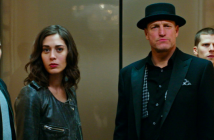
Editor’s Notes: The Light Between Oceans opens in limited theatrical release today, September 2nd.
If Blue Valentine, Derek Cianfrance’s third feature-length film, announced the arrival of a new filmmaking talent, his second film, The Place Beyond the Pines, a fascinating, if flawed, exploration of masculinity and its discontents across two generations, confirmed Cianfrance’s willingness to take dramatic and narrative risks, even if they only half-succeeded. His latest film, The Light Between Oceans, an adaptation of M.L. Stedman’s bestselling 2012 novel, seems likes a step back ambition wise (e.g., major stars, big budget constraints, an adaptation vs. an original screenplay), but surprisingly enough, it’s not. Cianfrance’s adaptation has the scale, sweep, and scope of a David Lean film (Brief Encounters, Lawrence of Arabia, Dr. Zhivago), taking moviegoers on a travelogue through the beautifully desolate, remote corners of Western Australia. Cianfrance also unapologetically embraces the clichés and tropes of melodrama, minus the irony, skepticism, or camp typical of contemporary filmmaking. It represents the best of what the form offers: Emotional truths expressed through a literate, thoughtful script, standout, committed performances, and stunning, gorgeous visuals.
Emotional truths expressed through a literate, thoughtful script, standout, committed performances, and stunning, gorgeous visuals.

The Light Between Oceans opens with Tom Sherbourne (Michael Fassbender), a veteran returning home from the Great War (World War I). A man of few words and a perpetually anguished expression – Cianfrance smartly avoids going the flashback route to Tom’s WWI experience in France, instead letting Fassbender’s emotive performance tell the audience everything we need to know – Tom accepts a temporary contract to serve as a lighthouse keeper on a nearby island. Tom catches the eye of his employer’s daughter, Isabel (Alicia Vikander), but he characteristically brushes off her interest, considering himself unworthy and/or incapable of romantic attachments. On his first visit back to the mainland, however, Tom finds himself on a picnic with Isabel, exchanging awkward pleasantries before hinting at the immeasurable loss of human life he witnessed on the battlefield. Isabel reveals a loss of her own, the two brothers who never came back from the war, leaving her a sister without siblings. They hesitantly find common ground in their mutual loss.
Cianfrance intimately understands that no visual effect, no matter how expensive or impressive, can match a talented, skillful actor’s face for its deeply expressive, immersive possibilities.
Through artfully composed letters sent over a period if weeks and months, Tom and Isabel grow closer, eventually marrying. With the help – and sometimes the detriment – of Alexandre Desplat’s uneven, overemphatic score, Cianfrance skillfully charts Tom and Isabel’s early marriage, an idyll shattered by not one, but two miscarriages, the seemingly miraculous discovery of a baby and a body (the infant’s father) in a dingy, and the ill-considered, if well meaning decision to keep the child before the inevitable, inevitably discovery of the child’s biological mother, Hannah Roennfeldt (Rachel Weisz), and the moral, ethical, and legal consequences that follow. A rigid, uncompromising man who lives by an old-school, Old Testament code, Tom finds himself in a moral and ethical quandary, returning the child to the child’s rightful mother and potentially devastating – not to mention alienating – his wife or continue with the painfully uncomfortable fiction that the child, Lucy (Florence Clery), is their biological daughter.
To Cianfrance’s credit, he doesn’t paint Hannah as a villain, but as a victim devastated by the apparent loss of her husband and daughter, leaving the audience to sort and sift through ever-shifting sympathies (Hannah, Tom, or Isabel). It’s the kind of ethical and morally ambiguous quandary found in Cianfrance’s last two films as well, relationships soured and shattered by secret-keeping, impulsive decision-making, and unchangeable, ultimately insurmountable personal flaws, but unlike Blue Valentine or The Place Beyond the Pines where the central romantic relationships seemed doomed to end in heartbreak (or worse), The Light Between Oceans takes a more hopeful, optimistic position about the long-term viability of romantic relationships, albeit with the usual amounts of cathartic heart-wringing and tear-inducing moments that practically define the melodrama as a genre.
It helps too, of course, that Cianfrance had three incredibly expressive actors, Fassbender, Vikander, and Weisz (two Oscar winners, Vikander and Weisz, and an Oscar nominee, Fassbender), to elevate already elevated material. All three actors give emotionally raw, emotionally vulnerable performances, performances made all the more affecting and arresting due to Cianfrance’s decision to privilege close-ups over medium or wide shots, especially during key, narrative-changing moments. Cianfrance intimately understands that no visual effect, no matter how expensive or impressive, can match a talented, skillful actor’s face for its deeply expressive, immersive possibilities.
Unlike Blue Valentine or The Place Beyond the Pines where the central romantic relationships seemed doomed to end in heartbreak (or worse), The Light Between Oceans takes a more hopeful, optimistic position about the long-term viability of romantic relationships, albeit with the usual amounts of cathartic heart-wringing and tear-inducing moments that practically define the melodrama as a genre.



